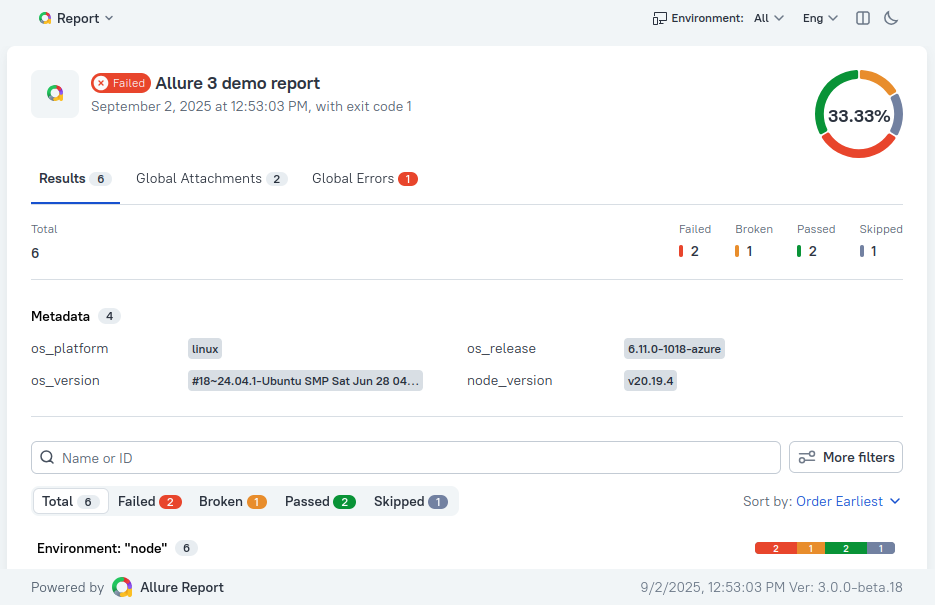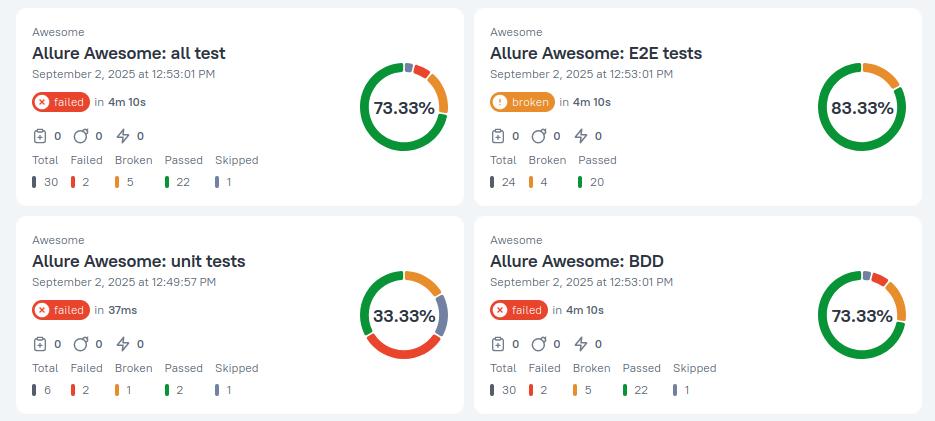Allure Report 3

Allure Report 3 is the newest version of the Allure reporting framework, rebuilt from the ground up with a new architecture and expanded capabilities.
Like its predecessor, Allure 2, it supports many languages and frameworks and can be added to your testing workflow with little to zero configuration. It produces visually rich HTML reports based on your test results that can be opened anywhere and read by anyone, no deep technical knowledge required.
Unlike its predecessor, this version is developed in TypeScript and introduces a modular plugin system for greater flexibility. A key addition is the Awesome plugin, which delivers an enhanced UI for better report visualization.
TIP
Note: Allure 3 is currently in beta and under active development. Stay tuned for the upcoming release.
What's New in Allure 3

Allure 3 introduces several notable improvements:
The framework has been entirely rewritten in TypeScript, making it more extensible and easier to maintain. Its plugin system allows you to customize and extend reporting functionality to fit your specific needs.
Configuration is simpler: a single file manages all report settings, making it more convenient to handle multiple reports.
Reruns in case of test failure are now supported. The results of the reruns are all grouped together in a single report.
You can now create lists of known issues, which Allure will take into account when labeling your test results.
Allure 3 adds real-time reporting, which lets you view live updates during test execution using the watch command.
Allure 3 supports project-wide quality gate settings, enabling fast fails of test runs that generated a critical amount of failed tests.
Allure 3 introduces the Allure Service feature for the first time - a built-in cloud storage for your test history.
Certain previously standalone test result readers are becoming part of Allure's core functionality with version 3.
Limitations While in Beta
While still in Beta, official CI/CD integrations and IDE plugins are not yet available for Allure 3.
Currently Allure 3 can only be installed via npm. Various other installation options will become available after it comes out of beta.
Get started with Allure
The quickest start: install Allure Report, run your tests the same way as you do it now, make sure you've got results in the supported formats, then and run Allure Report to turn those results into a beautiful HTML report.
Ready for more? Install one of the Allure adapters — framework-specific libraries that collect even more data during your tests. Use the API provided by the adapter to enable advanced Allure features like steps, attachments, test hierarchies, and more.
Need a bigger picture? Consider using Allure TestOps — our paid offering that allows you to track both manual and automated test cases, aggregate test results from a wide range of sources and analyze them across multiple launches and projects.
Control your data flow
A testing workflow with Allure Report consists of two steps, both of which can be done locally, without sending anything over the wire.
- Collection phase: while the tests are running, the test framework writes their results into a file or directory.
- Visualization phase: the Allure Report command-line utility reads the test results and builds an HTML report.
Once the HTML report is generated, you can safely remove the test results — for example, as part of a cleaning procedure before the next test run.

Allure recognizes test results in many formats, including our own data format. Its support can be added to many popular frameworks by using Allure adapters, and some frameworks even support it natively. In this data format, each test result is stored as a separate JSON file with a randomly generated filename.
The Allure's data format and the file-based data flow is:
- parallelizable: you can run tests on multiple nodes as long as you merge all the results into a single directory before the visualization phase;
- framework-agnostic: the framework-agnostic data format is perfect for projects that span across multiple programming languages and test frameworks;
- failure-tolerant: you can build a report based on the test results that you have even if other tests did not write their files due to an unexpected issue;
- extensible: feel free to filter or modify the test results between the two phases, thanks to the well-documented data format.
See How it works for a more detailed overview of the typical data flow in Allure Report.
Organize reports your way
A test report built by Allure is not locked to a specific service — it is just a small static HTML website.
You can open a report on any computer using the Allure Report utility itself or even just a browser. This gives you maximum flexibility when in comes to sharing or publishing the report.
- Send a report as a ZIP archive to your colleague that needs to see it.
- Store the reports on your web server, with links to previous reports.
- Use the integration plugins to embed reports into your CI tool's interface.
For more information, see How to view a report.
The Allure ecosystem
The Allure Report utility itself is a part of a larger ecosystem, supported by both Qameta Software and the broad community.
The ecosystem includes:
Adapters that enable support for the Allure data format in various test framework.
Using an Allure adapter for your framework is recommended to enable more features, such as steps, attachments, and test hierarchies.
Library adapters for logging certain type of events during the test, e.g., HTTP requests, database queries, assertions, etc.
Coming soon to Allure 3: IDE integrations for building reports from JetBrains IDEs or Visual Studio Code.
Coming soon to Allure 3: CI/CD integrations for building and publishing reports as part of your pipeline.
Allure TestOps — a paid Allure Report replacement that manages test results across multiple launches for even deeper analysis.
Most of the tools (with the exception of Allure TestOps) are open source under Apache License 2.0.